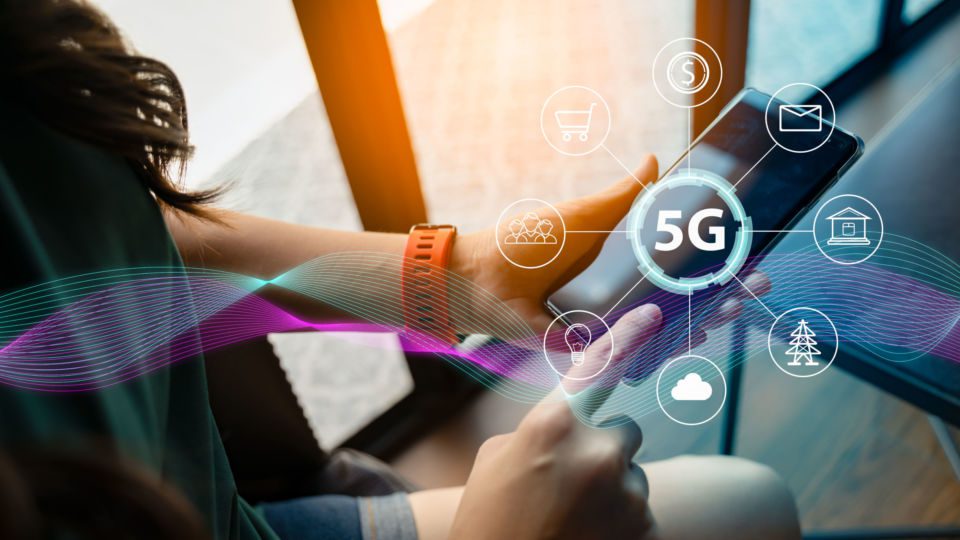 Are you prepared to deliver an improved customer experience, enabled by the next-generation mobile technology known as 5G? The higher speeds and lower latency that come with 5G promise to increase convenience and reduce friction in the shopping experience. But to deliver the 5G-enabled experience their customers soon will be expecting, retailers must lay the groundwork now.
Are you prepared to deliver an improved customer experience, enabled by the next-generation mobile technology known as 5G? The higher speeds and lower latency that come with 5G promise to increase convenience and reduce friction in the shopping experience. But to deliver the 5G-enabled experience their customers soon will be expecting, retailers must lay the groundwork now.
“5G will take the consumer market by storm,” tech research firm Omdia declares in a new report, which projects that 5G-enabled smartphone shipments will increase dramatically —from 29 million units shipped in 2019 to 231 million units shipped in 2020 — with another doubling in 2021.
As these figures suggest, it’s no longer a question of if but when the world will make the leap to fifth-generation wireless communications technology. As a retailer, your imperative is to be ready when that time comes, whether that’s this year or in 2025, when Ericsson, which develops digital solutions for communications providers, expects 5G to cover up to 65% of the world’s population, with a 74% uptake in North America.
With its promise of higher data speeds, lower latency and greater reliability, 5G already is providing a glimpse of what it can do in various pockets of the U.S. and around the globe. A movie that takes a few minutes to download on a 4G LTE network takes only a few seconds to download with 5G, for example. This dramatic improvement has broad ramifications for retailers, for its ability to enrich the customer experience and to strengthen operational efficiency, particularly when it’s coupled with Internet of Things (IoT) data collection points and artificial intelligence.
Advertisement
“Interactive and ongoing customer engagement during the presale and post-sale stages are the new benchmark to match. 5G promises to support this transformation at several layers — in addition to enhancing supply-chain and back-office operations,” posits Forrester, summarizing findings from a recent report on 5G in retail.
With the hype around 5G finally yielding to real-life use cases, retailers must start reaching for that benchmark in earnest. Here, direct from the front lines of 5G adoption, are five suggestions to guide retail enterprises in their 5G preparations.
1. Invest to boost your IoT capabilities. Ericsson expects the number of IoT cellular connection points to grow rapidly with the spread of 5G, from 1.3 billion in 2019 to five billion by the end of 2025. With more 5G-connected IoT points, retailers gain the ability to collect more data faster, which likely will have a major impact operationally and on the customer experience. For retailers, more in-store 5G-enabled IoT-connected sensors will have broad implications on the supply chain, bringing real-time inventory visibility, demand-based dynamic pricing, automated checkout, automatic inventory replenishment and other technologies into the mainstream. Ultimately, with more robust data flowing faster to machine learning- and AI-enabled analytics tools, not only will overall supply chain efficiency improve, but more operational and inventory decisions will be automated, freeing up managers and store associates for customer-facing activities.
2. Emphasize enhancing the customer experience. It looks like a typical clothing store dressing room, but behind the door, the stall also houses a touchscreen, enabling the customer to contact on-floor sales staff in the moment to bring a different size or color right to their stall. That same touchscreen also suggests shirts and shoes that match the pants the customer is trying on. By enabling real-time data transfer, 5G will give retailers a wide range of ways to build and deepen relationships with new and existing customers via interactive tools like augmented reality and virtual reality, personalized in-store content and offers and more.
3. Identify weak links in your infrastructure. Data can transmit only as fast as the slowest component of your system. So be sure to evaluate every element of your system — routers, switches, wiring, etc. — and take the necessary steps to address a potential bottleneck.
4. Consider in-store fixed wireless to improve signal strength. If 5G has an Achilles heel, it’s the low penetrability of its signal. Simply put, it’s not great at going through walls, glass, brick and other materials. The most viable solution for a retail environment could well be fixed wireless infrastructure that captures a concentrated 5G signal, then distributes it throughout a store.
5. Plan for outages. With greater reliance on IoT and edge devices come new challenges related to caching the data those devices collect. If the 5G network or a particular connection goes down, what happens to all the data being collected in real time? The answer could be more IoT points with in-device memory and the ability to work offline.
These are the kinds of issues retailers should be focusing on today if they are to capitalize on the massive, potentially game-changing possibilities that 5G promises to bring in the next several years.
Jeffrey Neville is industry go-to-market lead, retail, at Windstream. He’s based in Boston.





